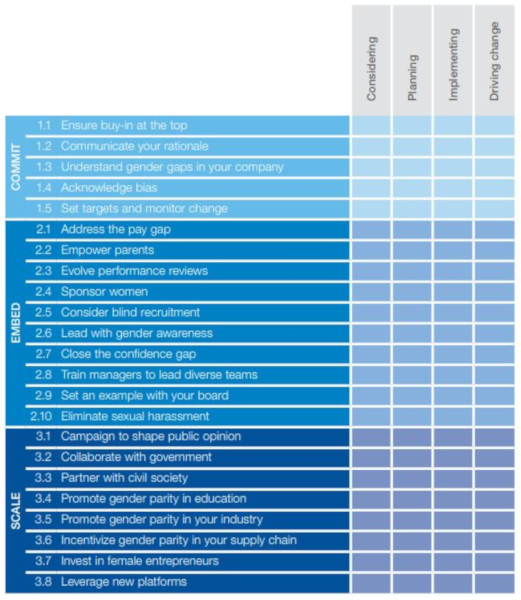An intro to Gild Collective and a way to help your organization move forward
By Rachel Bauer, co-founder of Gild Collective
At Gild Collective, we work with organizations to design and facilitate women’s leadership workshops and gender inclusion trainings. We approach gender diversity and inclusion in the workplace from two perspectives: giving women the tools they need to succeed (leadership workshops) and creating an environment where women can truly thrive (gender inclusion trainings). Most often we work with women’s employee resource groups, sometimes called “networks” or “initiatives.” Sometimes these groups were started and are run by a group of employees passionate about women’s issues in the workplace, and sometimes the groups are a top-down initiative from the head of human resources or diversity and inclusion that might even work in a completely different region of the country.
All of that is to say, there is no set formula to how (or even if) an organization runs a women’s initiative, so all our client relationships are unique. While it might seem preferable to work directly with the “passionate group,” that group might struggle to find footing, organizational structure and budget for their programs. The HR-led group might have all the budget and structure that they want, but struggle to find engagement and passion within their employees. We approach every client relationship differently, but always start at the same place: data.
Data as a catalyst for change
Every organization is at a different place in their journey to gender parity. As we have worked to develop our workshop modules since 2015 we have learned not to expect every client to have gathered unbiased insights from their female workforce, although some have robust data sets from which we can determine the key issues women in their organization want to focus on. In the accounting field, it is unlikely that small to midsize firms have internal statistics related to women’s engagement and retention, but we have benchmarking data from AICPA and the Ohio Society of CPAs.
Our goal is always to understand the unique challenges for women in the field, what support looks like from leadership and how all members of an organization perceive the women’s initiative and gender inclusion efforts. Since founding the company in 2015, we have seen accounting firms that land at all points across this spectrum, from new-and-exciting to old-and-stale programs. If we aren’t sure where an organization falls (or if you are not sure where your organization falls), we bring in the World Economic Forum’s assessment from 2018’s Accelerating Gender Parity Toolkit.
 The checklist at right comes from the toolkit, and it helps organizations measure their progress on the three categories across the spectrum: Commit, Embed and Scale. Regardless where an organization falls, there are challenges along the way we aim to help solve.
The checklist at right comes from the toolkit, and it helps organizations measure their progress on the three categories across the spectrum: Commit, Embed and Scale. Regardless where an organization falls, there are challenges along the way we aim to help solve.
A call to action:
My challenge to you is to complete this checklist for your organization to establish a baseline from which you can make change going forward. In the coming months I’ll provide insight into some of the most common challenges we have seen in working with accounting firms of all sizes.
Look for us on the OSCPA blog:
- February 2019– Challenge One:
- Lack of visibility of women in leadership: why it matters internally and externally for firms.
- March 2019– Challenge Two:
- Assumptions made about what female accountants need and want: why these assumptions hurt women, and how they stem from gender bias.
- April 2019– Challenge 3:
- Lack of mentorship and sponsorship firmwide, as well as lack of general networks of support.
We will conclude our series in the May/June 2019 issue of CPA Voice with guidance on how to assess your own organizational culture for best practices in gender inclusion and give step-by-step tools that you can implement within your firm at minimal cost.
Related: Attend the Women, Wealth and Wellness Conference on June 27.